
The postage stamps and postal system of the Confederate States of America carried the mail of the Confederacy for a brief period in U.S. history. Early in 1861 when South Carolina no longer considered itself part of the Union and demanded that the U.S. Army abandon Fort Sumter, plans for a Confederate postal system were already underway. Indeed, the Confederate Post Office was established on February 21, 1861; and it was not until April 12 that the American Civil War officially began, when the Confederate Army fired upon U.S. soldiers who had refused to abandon the fort. However, the United States Post Office Department continued to handle the mail of the seceded states as usual during the first weeks of the war. It was not until June 1 that the Confederate Post Office took over collection and delivery, now faced with the task of providing postage stamps and mail services for its citizens.

Libby Prison was a Confederate prison at Richmond, Virginia, during the American Civil War. In 1862 it was designated to hold officer prisoners from the Union Army, taking in numbers from the nearby Seven Days battles and other conflicts of the Union's Peninsular campaign to take Richmond and end the war only a year after it had begun. As the conflict wore on the prison gained an infamous reputation for the overcrowded and harsh conditions. Prisoners suffered high mortality from disease and malnutrition. By 1863, one thousand prisoners were crowded into large open rooms on two floors, with open, barred windows leaving them exposed to weather and temperature extremes.
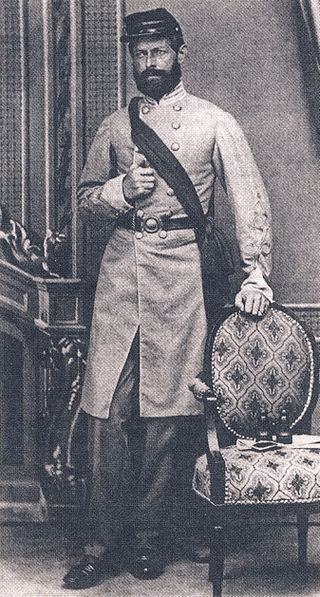
Henry Wirz was a Swiss-born American military officer and convicted war criminal who served in the Confederate States Army during the American Civil War.

Tobacco Row is a collection of tobacco warehouses and cigarette factories in Richmond, Virginia adjacent to the James River and Kanawha Canal near its eastern terminus at the head of navigation of the James River.

The Battle of Yellow Tavern was fought on May 11, 1864, as part of the Overland Campaign of the American Civil War. Union cavalry under Maj. Gen. Philip Sheridan was detached from Grant’s Army of the Potomac to conduct a raid on Richmond, Virginia, and challenged Confederate cavalry commander Maj. Gen. J.E.B. Stuart. The Confederates were outnumbered, and Stuart was mortally wounded. However, Sheridan’s 'sideshow' did not achieve any of its other objectives, and had meanwhile deprived Grant’s army of key cavalry functions at Spotsylvania.

The Dahlgren affair was an incident during the American Civil War which stemmed from a failed Union raid on the Confederate capital of Richmond, Virginia in March 1864. Brigadier General Hugh Judson Kilpatrick and Colonel Ulric Dahlgren led an attack on Richmond to free Union prisoners from Belle Isle and damage Confederate infrastructure.
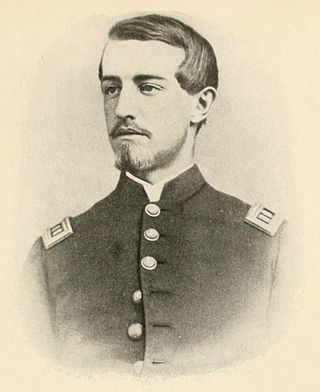
Ulric Dahlgren was a colonel in the Union Army during the American Civil War. He was the son of Union Navy Rear Admiral John A. Dahlgren and nephew to Confederate Brigadier General Charles G. Dahlgren.

The U.S. state of West Virginia was formed out of western Virginia and added to the Union as a direct result of the American Civil War, in which it became the only modern state to have declared its independence from the Confederacy. In the summer of 1861, Union troops, which included a number of newly formed Western Virginia regiments, under General George McClellan, drove off Confederate troops under General Robert E. Lee. This essentially freed Unionists in the northwestern counties of Virginia to form a functioning government of their own as a result of the Wheeling Convention. Before the admission of West Virginia as a state, the government in Wheeling formally claimed jurisdiction over all of Virginia, although from its creation it was firmly committed to the formation of a separate state.
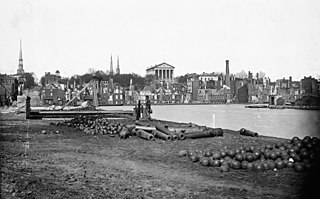
Richmond, Virginia served as the capital of the Confederate States of America during the American Civil War from May 8, 1861, hitherto the capital had been Montgomery, Alabama. Notwithstanding its political status, it was a vital source of weapons and supplies for the war effort, as well as the terminus of five railroads, and as such would have been defended by the Confederate States Army at all costs.

The Libby Prison escape was a prison escape from Libby Prison, a Confederate prison at Richmond, Virginia in February 1864 that saw over 100 Union prisoners-of-war escape from captivity. It was one of the most successful prison breaks of the American Civil War.
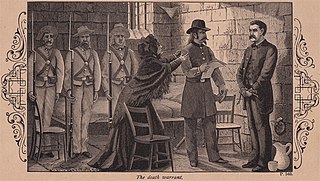
Hattie Lawton, also known as Hattie H. Lawton, Hattie Lewis, and Hattie Lewis Lawton was an American detective, who worked for Allan Pinkerton, of the Pinkerton Detective Agency. Lawton may have been born around 1837, although most details of her life, before and after the American Civil War, are unknown. "[Hattie] Lawton was part of Pinkerton's Female Detective Bureau, formed in 1860 to 'worm out secrets' by means unavailable to male detectives."

Camp Morton was a military training ground and a Union prisoner-of-war camp in Indianapolis, Indiana, during the American Civil War. It was named for Indiana governor Oliver Morton. Prior to the war, the site served as the fairgrounds for the Indiana State Fair. During the war, Camp Morton was initially used as a military training ground. The first Union troops arrived at the camp in April 1861. After the fall of Fort Donelson and the Battle of Shiloh, the site was converted into a prisoner-of-war camp. The first Confederate prisoners arrived at Camp Morton on February 22, 1862; its last prisoners were paroled on June 12, 1865. At the conclusion of the war, the property resumed its role as the fairgrounds for the Indiana State Fair. In 1891 the property was sold and developed into a residential neighborhood known as Morton Place, a part of the Herron-Morton Place Historic District.

The Beefsteak Raid was a Confederate cavalry raid that took place in September 1864 as part of the Siege of Petersburg during the American Civil War. Confederate Maj. Gen. Wade Hampton led a force of 3,000 troopers of the Confederate States Army on what was to become a 100-mile (160 km) ride to acquire cattle that were intended for consumption by the Union Army, which was laying a combined siege to the cities of Richmond and Petersburg, Virginia.
USS Emily was a Union steamer during the American Civil War.
Anne Olivia Floyd was a Confederate spy during the American Civil War, noted as a blockade runner.

Charles H. Marsh was a Union Army soldier in the American Civil War and a recipient of the United States military's highest decoration, the Medal of Honor, for his actions during a skirmish in the Valley Campaigns of 1864.

Between 1861 and 1865, American Civil War prison camps were operated by the Union and the Confederacy to detain over 400,000 captured soldiers. From the start of the Civil War through to 1863 a parole exchange system saw most prisoners of war swapped relatively quickly. However, from 1863 this broke down following the Confederacy's refusal to treat black and white Union prisoners equally, leading to soaring numbers held on both sides.
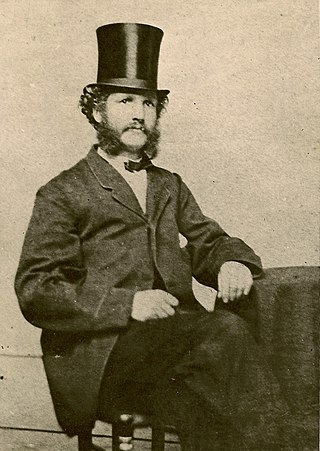
Pryce Lewis was an operative of the Pinkerton Detective Agency and Union spy during the American Civil War. His activities in Charleston, Virginia and the surrounding area heavily assisted the Union Army during the early years of the war. Lewis was later captured and played a part in the trial and execution of fellow agent Timothy Webster.

George Nichols Hollins (1799–1878) was an American Captain and Naval Base Commander, in the US Navy and later a Captain and Commodore in the Confederate Navy. He famously won the Battle of the Head of Passes, a naval battle of the American Civil War, returning to New Orleans a hero.
On June 20, 1863 the U.S. government created a new state from 50 western counties of Virginia to be named "West Virginia". This was done on behalf of a Unionist government in Wheeling, Virginia, approved by Congress and President Lincoln, though it was done with a low participation of the citizens within the new state. There remained a large number of counties and citizens who still considered themselves as part of Virginia and the Confederacy which, in turn, considered the new state as part of Virginia and the Confederacy. In 1861 the 50 counties contained a population of 355,544 whites, 2,782 freemen, 18,371 slaves, 79,515 voters and 67,721 men of military age. West Virginia was the 6th most contested state during the war, with 632 battles, engagements, actions and skirmishes.



















